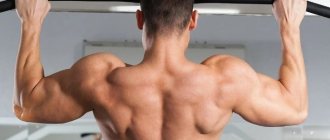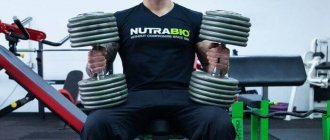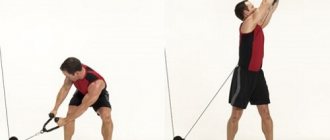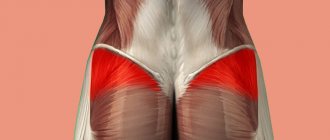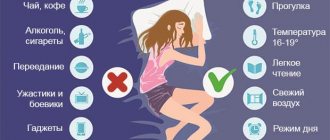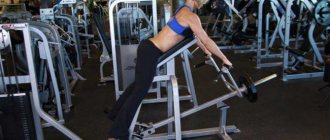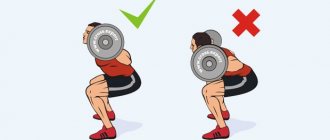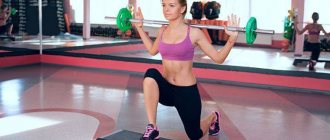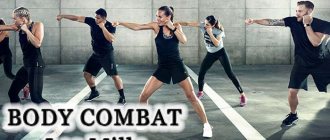September 27, 2022 Admin Home page » Training in the gym
What is Upper body and what is special about this fitness training. Advantages and disadvantages. List of exercises. Suitable for: Training video.
Fitness has now firmly entered people's lives and it is not surprising that new directions are being developed in it, one of which is Upper body, the details of which you will learn below. It is this training method that will help to specifically pump up the lagging part of the body, achieving harmony in the physique.
What is upper body in fitness
Translated from English, upper is the upper part, body is the body; adding these two phrases, you get the upper part of the body. This means that the training is fundamentally aimed at using the upper part of the muscles.
All exercises are performed with the help of fitness bands, dumbbells, step platforms, etc., as well as with your own weight. Don't forget push-ups and planks. The duration of the workout should be around 50-60 minutes.
This type of direction should be performed to fast music so that the psyche is in good shape, because most exercises follow each other with minimal pauses. During the training, it is allowed to perform 2-3 exercises in different combinations for several approaches.
In addition to toning your muscles and giving them definition, upper body training will help you get rid of excess weight and achieve a slim figure. In order for fat burning to occur faster, it is necessary to combine the exercise of the upper muscles with training of the lower body.
Upper body training should not become the main one and be used to tighten weak points. It is much more effective to combine training with other methods for the harmonious development of the figure.
Benefit
If you decide to take your figure seriously and bring it to ideal, Upper Body programs are great for this. By signing up for a lesson, the athlete gets excellent results:
- Significant development of endurance and other physical indicators. The body tolerates various loads much easier.
- Improved posture. With regular training, your shoulders and back straighten. The body becomes perfectly straight, which, of course, affects the position of the head and the gaze, which from now on is directed only forward.
- Developing self-discipline. Over time, the athlete develops the habit of quality training in a group or independently in the gym. For beginners, additional stimulation is provided by a trainer, under whose guidance he performs exercises.
- Increased self-confidence. During training, the body actively produces the hormone of happiness - endorphin. It stabilizes the athlete’s emotional state and fills him with energy, which is so necessary to perform difficult exercises.
Interesting fact. Many girls consider it irrelevant to develop endurance in their body. However, this property is very important for the fair sex, because men will not always be there to help.
What does upper body training include?
For the training to be as effective as possible, you must:
♦ warm up for 5-7 minutes to prepare the ligaments and tendons, as well as warm up the muscle fibers;
♦ then the main part of the training program is performed for 40-45 minutes;
♦ at the very end, you need to devote time to the abdominal muscles, preferably performing different exercises, alternating them;
♦ after the abdominal muscles, you need to pay attention to 5-7 minutes to cool down and stretch the muscles that were subjected to physical activity.
Principles for selecting the weight of sports equipment
First of all, weight selection is carried out based on the level of general physical fitness. However, general principles apply to everyone, and include the following rules regarding performing exercises with maximum loads:
- reducing weight for deadlifts if push-ups were done before;
- limiting the weight of weights on the bar to 10, maximum 15 kg on each side;
- performing deadlifts only with a barbell, and not with a light body bar (excessive weight reduction for this exercise is also not recommended, since it simply will not make sense).
Advantages and disadvantages
Advantages:
⇒ perfectly trains the muscles of the upper body;
⇒ improves the dynamics of joint mobility;
⇒ the load on the heart and blood vessels is within normal limits;
⇒ suitable for all ages, the main thing is to choose the right intensity and load;
⇒ helps you lose weight with a well-formed diet.
Flaws:
⇒ highly specialized focus of training;
⇒ To burn body fat properly, you need to include lower body workouts.
Specific training methods for muscle hypertrophy
Forced reps, weight loss sets, supersets, and heavy negative reps are popular training methods for developing muscle. Despite the insufficient number of studies assessing their effect on muscle hypertrophy, a large amount of indirect evidence provides a reliable theoretical basis for the positive effect. The following sections discuss the applicability of these methods to hypertrophy training.
Forced reps
Forced repetitions (repetitions with assistance) involve the actions of the spotter, which consist of assistance in performing additional repetitions after the onset of the goal, often helping to complete movements after the “dead point”. It is hypothesized that forced repetitions may enhance the hypertrophic stimulus by increasing MU fatigue or metabolic stress.
There are different opinions among researchers regarding the importance of GH for the anabolic response. However, it has been experimentally established that the increase in GH in response to training is closely correlated with the amount of hypertrophy of type I and II muscle fibers, as well as muscle adaptation to force development (26, 49). According to the data obtained, this may be due to the ability of GH to enhance the activation of the IGF-1 gene in muscles, to increase the conversion of IGF-1Ea to the MGF isoform (27, 36). More research is needed to determine the role that increased GH plays in exercise-induced hypertrophy and, if positive, whether it represents a benefit when incorporating forced repetitions into muscle-building programs.
Weight Loss Approaches
Similar to forced reps, weight reduction sets involve performing a set to muscle failure, using a rapid reduction in load and continuing the set until the next failure. It has been suggested that this method can stimulate greater muscle growth by increasing MU fatigue (75). The increased time under load that occurs with weight loss approaches results in increased metabolic stress and ischemia, which provides an anabolic environment. Multiple weight reductions performed within one set increase fatigue and metabolic stress.
Some evidence suggests that weight loss approaches may enhance the anabolic environment following resistance exercise. Goto et al (22) evaluated the inclusion of a low-intensity set (50% RM) immediately after performing high-intensity sets. The result shows a spike in GH levels associated with the inclusion of a low intensity approach. In a follow-up study, Goto et al (21) showed that adding a weight loss approach to a standard strength training protocol resulted in a significant increase in muscle CSA compared to using the standard protocol alone. None of the studies controlled for total exercise volume, leaving the possibility of increased hormonal response and muscle protein accumulation due to increased exercise volume.
Unlike forced reps, drop sets do not require the presence of a spotter. This makes a person less dependent on exercising, giving more control to control the intensity.
Given that forced reps and weight reduction sets involve training to muscle failure, caution must be exercised when integrating these techniques into muscle hypertrophy programs. Chronic training to muscle failure over time increases the risk of overtraining and burnout (17) and can lead to decreased IGF-1 concentrations and resting testosterone levels (38). Thus, it is recommended to use forced repetitions and weight reduction sets in the context of load periodization. Typically this means limiting their use to multiple sets within a microcycle, making sure that periods of strain are interspersed with sufficient periods of recovery. It is known that recovery abilities vary from person to person and are dependent on nutrient supply, anabolic steroid use, and other factors that may allow for more frequent use of these methods.
Supersets
According to Robbins et al (57), pairing exercises allows more repetitions to be performed per unit time without significantly reducing the intensity or overall volume of the workout. This increase in activity density increases the training impact, which is necessary to increase the degree of fatigue. Increased fatigue, in turn, may help stimulate hypertrophy (59). Although signs of metabolic stress have not been studied, increasing exercise density requires greater recruitment of anaerobic glycolysis, optimizing the anabolic environment.
Heavy negative repetitions
Heavy negative reps (supermax eccentric contractions) involve performing eccentric contractions with a load greater than your concentric maximal maximal maximal reps. This usually requires a spotter to help lift the weight in the concentric phase, followed by an eccentric repetition. The exerciser can perform several repetitions depending on the intensity of the workout. Considering that muscle fatigue may not be complete with concentric repetitions (75), the use of heavy negative repetitions may lead to greater fatigue of the motor units and thus provide an additional stimulus for hypertrophy.
A significant number of studies have shown that eccentric exercise produces greater gains in lean muscle mass compared to isometric and concentric contractions (15, 16, 30, 54).
Hather et al (28) found that maximum muscle hypertrophy in response to resistance exercise is not achieved unless eccentric muscle contractions are performed. In this regard, eccentric contractions are associated with the most rapid increases in protein synthesis (51), greater increases in IGF-1 mRNA expression (64), and greater increases in p70S6k (13), compared with other types of contractions.
Several explanations have been proposed for the hypertrophy benefits of eccentric exercise. First, they are associated with greater damage to muscles that have been shown to produce a hypertrophy response, as previously noted (14, 31). Muscle damage is manifested by tortuosity of Z-lines, which, according to modern research, indicates myofibril remodeling (10, 76). Z-lines are critical sites of mechanotransduction, and localized damage is thought to promote hypertrophy signaling pathways (34). C-Jun NH 2 terminal kinase (JNK), the signaling portion of MAPK, is particularly sensitive to muscle damage caused by eccentric contractions (7). Activation of JNK by eccentric contractions is associated with a significant increase in the transcription of mRNA factors involved in cell proliferation and DNA-mediated tissue repair (2, 3, 7).
Eccentric exercise has also been shown to preferentially recruit fast-twitch muscle fibers (53, 64, 69) and may also recruit previously inactive motor units (50, 53). Increased recruitment of high-threshold motor units occurs in conjunction with decreased activation of slow-twitch fibers, leading to an increase in relative motor unit stress (25, 45). The overall result is an increase in mechanical tension in type II fibers, which have the greatest potential for muscle growth, which is associated with their anaerobic phenotype (42, 70). This was demonstrated by Hortobagyi et al (35), who examined the effect of eccentric versus concentric contractions on quadriceps CSA. After 12 weeks of study, type I fiber diameter did not differ significantly between groups, but eccentric exercise resulted in an increase in type II fiber diameter 10 times greater than concentric exercise.
Finally, eccentric training is associated with increased metabolic stress. According to Ojasto and Hakkinen (55), after exercise with an accentuated eccentric contraction, there was a greater increase in lactate production and concomitant hormone release than during training with a high intensity eccentric contraction.
Considering that eccentric strength exceeds concentric strength by 20–50% (5), it is recommended to perform heavy negative repetitions with a load of 105–125% of the concentric RM. This allows a person to perform multiple repetitions at supramaximal intensity. An eccentric contraction duration of 2–3 seconds has been suggested as optimal for maximal hypertrophy response (61).
As with forced repetitions, the disadvantage of heavy negative repetitions is that they require the help of a spotter, and in the case of using free weights, two spotters may be needed if the weight is significant. In addition, forced repetitions can overload the neuromuscular system and, thus, stimulate the onset of overtraining. Therefore, caution must be exercised when incorporating these techniques into hypertrophy training programs.
conclusions
Incorporating forced reps, weight loss sets, supersets, and heavy negative reps separately into hypertrophy resistance training programs has been shown to have positive effects. Difficulties in making recommendations for intensity and volume to stimulate hypertrophy stem from the paucity of studies directly evaluating the techniques. The potential to induce fatigue and increase the risk of overexertion and overtraining requires well-planned, limited use of these techniques, in no more than a few microcycles, as part of a periodized exercise program. However, recovery abilities vary significantly between individuals, and individual frequency and volume need to be adjusted experimentally. For optimal results, possible signs of overtraining must be constantly monitored.
Additionally, these methods should be considered advanced training strategies. Their use has a significant effect on the neuromuscular system, which exceeds the adaptive capabilities of beginners. Based on the author's experience, a minimum of several months of systematic training is required before incorporating the described methods into training programs.
Source:
BradSchoenfeld
Who is the training suitable for?
Upper body training is suitable for all age groups for women and men. An exception will be the category with joint diseases, the presence of heart problems, recent operations and the rehabilitation period.
It is advisable to consult a doctor before starting training, or at least tell your gym trainer about all your heart problems.
The direction will become an alternative for temporary exercises from heavy strength loads, it seems to be the same exercises, but in practice the load is slightly different.
In a word, if you want to tighten your body, make it sculpted, athletic and toned, do not pass by this area of fitness.
Achieved results
The gym, which serves mainly for working with serious weights, involves no more than 8-12 repetitions of certain actions.
In fitness programs, of which Upper Body is one, the situation is the opposite. This complex, designed for training mainly not with a barbell, but with light dumbbells and body bars, allows each exercise to be repeated several dozen times. Strengthening muscle endurance and toning them is optimal, however, the program is not initially designed to acquire a powerful relief pattern and quickly build muscle mass. That is why Upper Body enjoys the greatest popularity among the fair half of humanity, for whose representatives flexibility and endurance do not imply the accompanying appearance of powerful and not very attractive muscles of the “male” type.
Features of training
It was not for nothing that it was mentioned that the music during the training process should be rhythmic. The trick of the training is that you need to perform the exercises using 4 techniques:
→ 4:4 – the up and down movement is performed for 4 beats to the music or, in extreme cases, 4 seconds;
→ 2:2 – movement in the relaxation or effort phase is performed for 2 beats to the music or 2 seconds;
→ 3:1 – one of the movements for effort or relaxation is performed with 3 beats of music, and the other with 1 beat;
→ 1:1 The fastest version of training is literally at a crazy pace, the stage of effort and relaxation is performed under 1 beat of music. Therefore, make sure in advance that there are no heart problems.
Having chosen one training scheme indicated above, the following exercises are most often performed:
Basic exercises in the program
An Upper Body workout most often includes the following exercises:
- Army press.
- Belt pull.
- Pushups.
- Pull to the shoulders from the position.
- Dumbbell extension from behind the head.
- Bench press.
- Biceps Curl.
- Reverse push-ups.
Of course, you can do these exercises on your own. However, it is important to understand that you will have to additionally control the execution technique.
Exercises for training Low body
The direction of Low body training is to work out the muscles: gluteus maximus, biceps and quadriceps (quadriceps), femoral, adductors, abs and lower back (rectus and oblique).
In most of the low body workout, the body is in an upright position. The intensity of classes decreases when moving to the strength part and towards the end of the workout.
The strength part includes effective basic exercises: squats, lunges, etc.
The training also uses local Lower body exercises. These are leg swings that work not only the hips, but also the gluteus maximus muscle.
Classes usually last 55 minutes, 30-35 minutes are devoted to leg muscle training.
Can Beginners Do Upper/Lower Splits?
Hiit training: what is it?
Beginners are absolutely capable of performing upper lower workout splits.
Most training styles are universal among training experience. The only things that may differ is the weight used, possibly some volume, and the inclusion of more advanced training techniques if necessary.
If you are a beginner, however, upper/lower workouts can definitely be a good style of training to start out with. You may also want to consider experimenting with full body workouts and determine which you enjoy more and works best for your individual goals, capabilities, and lifestyle.
The workout listed below can be a good workout for beginner lifters. Some may want to consider evaluating the total volume and eliminating sets if needed to optimize recovery. They may also want to remove the emphasized negatives if needed.
Another strategy for making upper/lower workouts beginner-friendly is changing the training frequency from 4 days of training per week to 3 days of training.
An example week following this strategy may look like:
- Monday: Upper Workout
- Tuesday: Rest
- Wednesday: Lower Workout
- Thursday: Rest
- Friday: Upper Workout
- Saturday: Rest
- Sunday: Rest
To continue on like this, you would simply continue to cycle through the workouts listed below on your training days.
Equipment for low body
Low body fitness workouts are carried out at varying intensities - medium or high. A variety of equipment can be used:
- dumbbells;
- rubber loops;
- weights;
- body bars;
- step platforms;
- fitballs;
- expanders and other projectiles.
Intense exercise causes profuse sweating, i.e. burn excess weight. Physical activity allows you to achieve the desired fit. Consultation with a trainer and testing different weights will help in choosing the optimal loads. This is necessary, since exercises that are too light will not bring the desired effect, and exercises that are too heavy will lead to muscle gain, which not everyone needs.
How to start?
Every healthy lifestyle enthusiast started somewhere. A beautiful figure and a healthy body are the result of working on yourself, they don’t just appear. Without a doubt, it will be difficult to start. A person lives by habit - he follows the rules and principles that have become commonplace for him. This makes you feel comfortable and protected.
Starting to learn about a healthy lifestyle and its components, trying to follow the prescribed recommendations, at first you will encounter certain difficulties. But only until a habit is formed. The Superbody service will create an individual nutrition plan and exercise program for you so that your body does not experience stress.
You will be pleasantly surprised how quickly the principles of a healthy lifestyle will become clear and simple for you, and the first results will only strengthen your motivation.
Bums+tabs – buttocks plus belly
Body pump training
Bums+tabs courses are available to anyone, regardless of their level of physical fitness. The name of the program stands for strength training of problematic female areas - this is the area of the buttocks and abdomen.
However, during Bums tabs classes, every muscle is worked out, but the main emphasis is on the abdominals and correction of the buttocks. Constant movement during training increases the body's endurance. Women of any age can learn Bums+tabs. The group in which the training will take place helps to create a spirit of competition and a desire for results.
